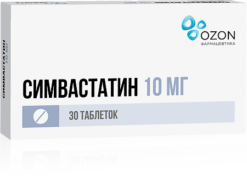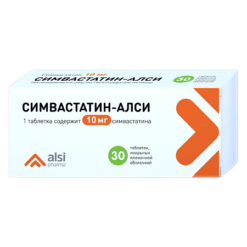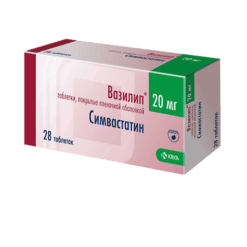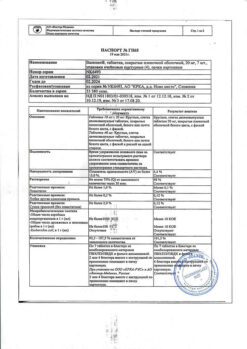No products in the cart.
Simvastatin-ALSI, 20 mg 30 pcs
€4.09 €3.64
Description
Hypolipidemic agent obtained synthetically from the fermentation product of Aspergillus terreus, is an inactive lactone, it undergoes hydrolysis in the body to form a hydroxy acid derivative.
The active metabolite inhibits 3-hydroxy-3-methyl-glutaryl-CoA reductase ‑(HMG-CoA reductase), the enzyme that catalyzes the initial reaction of mevalonate formation from HMG-CoA.
Because the conversion of HMG-CoA to mevalonate represents an early step in cholesterol synthesis, use of Simvastatin does not cause accumulation of potentially toxic sterols in the body. HMG-CoA is easily metabolized to acetyl-CoA, which is involved in many synthesis processes in the body.
It decreases plasma levels of triglycerides (TG), low-density lipoproteins (LDL), very low-density lipoproteins (VLDL) and total cholesterol (in cases of heterozygous familial and non-familial forms of hypercholesterolemia, mixed hyperlipidemia, when elevated cholesterol is a risk factor).
Enhances high-density lipoprotein (HDL) and decreases the ratio of LDL/HDL and total cholesterol/HDL.
The onset of the effect is 2 weeks after the start of administration, the maximum therapeutic effect is achieved after 4-6 weeks. The effect is maintained during continuation of treatment, when therapy is discontinued cholesterol content gradually returns to baseline levels.
Indications
Indications
Hypercholesterolemia:
Primary hypercholesterolemia (type IIa and IIb) with the ineffectiveness of low-cholesterol diet therapy and other non-drug measures (physical activity and weight loss) in patients with an increased risk of coronary atherosclerosis;
Combined hypercholesterolemia and hypertriglyceridemia, not corrected by a special diet and physical activity.
Coronary heart disease:
To prevent myocardial infarction,
To reduce the risk of death,
Reducing the risk of cardiovascular disorders (stroke or transient ischemic attacks),
Slowing the progression of coronary atherosclerosis,
Reducing the risk of revascularization procedures.
Pharmacological effect
Pharmacological effect
The lipid-lowering agent, obtained synthetically from the fermentation product of Aspergillus terreus, is an inactive lactone that undergoes hydrolysis in the body to form a hydroxy acid derivative.
The active metabolite inhibits 3‑hydroxy-3-methyl-glutaryl-CoA reductase (HMG-CoA reductase), the enzyme that catalyzes the initial reaction of mevalonate formation from HMG-CoA.
Since the conversion of HMG-CoA to mevalonate is an early step in cholesterol synthesis, the use of Simvastatin does not cause the accumulation of potentially toxic sterols in the body. HMG-CoA is easily metabolized to acetyl-CoA, which is involved in many synthesis processes in the body.
Causes a decrease in the blood plasma levels of triglycerides (TG), low-density lipoproteins (LDL), very low-density lipoproteins (VLDL) and total cholesterol (in cases of heterozygous familial and non-familial forms of hypercholesterolemia, with mixed hyperlipidemia, when high cholesterol is a risk factor).
Increases the content of high-density lipoproteins (HDL) and reduces the LDL/HDL ratio and total cholesterol/HDL.
The onset of the effect is 2 weeks from the start of administration, the maximum therapeutic effect is achieved after 4-6 weeks. The effect persists with continued treatment; upon cessation of therapy, cholesterol levels gradually return to the original level.
Special instructions
Special instructions
At the beginning of therapy with Simvastatin, a transient increase in the level of liver enzymes is possible.
Before starting therapy and then regularly conduct a liver function test (monitor the activity of liver enzymes every 6 weeks for the first 3 months, then every 8 weeks for the remaining first year, and then once every six months), and when increasing doses, a liver function test should be performed. When increasing the dose to 80 mg, a test must be performed every 3 months. If there is a persistent increase in transaminase activity (3 times compared to the initial level), Simvastatin should be discontinued.
Simvastatin, like other HMG-CoA reductase inhibitors, should not be used if there is an increased risk of rhabdomyolysis and renal failure (due to severe acute infection, arterial hypotension, planned major surgery, trauma, severe metabolic disorders).
Cancellation of lipid-lowering drugs during pregnancy does not have a significant effect on the results of long-term treatment of primary hypercholesterolemia.
In patients with low thyroid function (hypothyroidism) or certain kidney diseases (nephrotic syndrome), if cholesterol levels are elevated, the underlying disease should be treated first.
Simvastatin should be prescribed with caution to persons who abuse alcohol and/or have a history of liver disease.
Before and during treatment, the patient should be on a cholesterol-lowering diet.
Concomitant use of grapefruit juice may increase the severity of side effects associated with taking Simvastatin, so their simultaneous use should be avoided.
Simvastatin is not indicated in cases where there is hypertriglyceridemia of types I, IV and V.
Treatment with Simvastatin may cause myopathy leading to rhabdomyolysis and renal failure. The risk of this pathology increases in patients receiving one or more of the following drugs simultaneously with Simvastatin: fibrates (gemfibrozil, fenofibrate), cyclosporine, nefazadone, macrolides (erythromycin, clarithromycin), azole antifungals (ketoconazole, itraconazole) and HIV protease inhibitors (ritonavir). The risk of developing myopathy also increases in patients with severe renal failure.
All patients starting therapy with Simvastatin, as well as patients who need to increase the dose of the drug, should be warned about the possibility of myopathy and the need to immediately seek medical attention if unexplained pain, muscle soreness, lethargy or muscle weakness occurs, especially if accompanied by malaise or fever. Drug therapy should be discontinued immediately if myopathy is diagnosed or suspected.
In order to diagnose the development of myopathy, it is recommended to regularly measure the CPK value.
When treated with Simvastatin, an increase in serum CPK levels is possible, which should be taken into account in the differential diagnosis of chest pain. The criterion for discontinuation of the drug is an increase in the CPK content in the blood serum by more than 10 times relative to the upper limits of normal. In patients with myalgia, myasthenia gravis and/or a marked increase in CPK activity, treatment with the drug is discontinued.
The drug is effective both as monotherapy and in combination with bile acid sequestrants.
If you miss the current dose, the drug must be taken as soon as possible. If it is time for the next dose, do not double the dose.
In patients with severe renal failure, treatment is carried out under the monitoring of renal function.
The duration of use of the drug is determined individually by the attending physician.
Impact on the ability to drive a car and operate machinery
No adverse effects of the drug on the ability to drive a car or operate machinery have been reported.
Active ingredient
Active ingredient
Simvastatin
Composition
Composition
One film-coated tablet contains:
Active substance:
Simvastatin – 20 mg
Excipients:
Microcrystalline cellulose – 140.00 mg
Lactose monohydrate (milk sugar) – 42.00 mg
Pregelatinized starch (starch 1500) – 67.46 mg
Colloidal silicon dioxide (Aerosil) – 1.50 mg
Ascorbic acid – 5.00 mg
Butylated hydroxyanisole – 0.04 mg
Stearic acid – 2.50 mg
Magnesium stearate – 1.50 mg
Polyvinyl alcohol – 4.66 mg
Macrogol (polyethylene glycol) – 2.36 mg
Iron dye black oxide – 0.04 mg
Talc – 1.72 mg
Iron oxide yellow dye – 0.56 mg
Iron oxide red dye – 0.38 mg
Titanium dioxide – 1.94 mg
Contraindications
Contraindications
A history of hypersensitivity to simvastatin or to other components of the drug (including hereditary lactose intolerance), as well as to other statin drugs (HMG-CoA reductase inhibitors);
Liver diseases in the active phase, persistent increase in the activity of “liver” enzymes of unknown etiology;
Diseases of skeletal muscles (myopathy);
Age up to 18 years (efficacy and safety have not been established).
Prescribe with caution to patients:
Alcohol abuser
Patients after organ transplantation who are receiving immunosuppressant therapy (due to an increased risk of rhabdomyolysis and renal failure)
In conditions that can lead to the development of severe renal failure, such as arterial hypotension, severe acute infectious diseases, severe metabolic and endocrine disorders, water and electrolyte imbalance, surgical interventions (including dental) or trauma
Patients with decreased or increased skeletal muscle tone of unknown etiology;
Epilepsy
Side Effects
Side Effects
From the digestive system: possible abdominal pain, constipation, flatulence, nausea, diarrhea, pancreatitis, vomiting, hepatitis, increased activity of liver enzymes, alkaline phosphokinase and creatine phosphokinase (CPK).
From the nervous system and sensory organs: asthenic syndrome, headache, dizziness, insomnia, muscle cramps, paresthesia, peripheral neuropathy, blurred vision, impaired taste.
From the musculoskeletal system: myopathy, myalgia, muscle cramps, weakness; rarely – rhabdomyolysis.
Allergic and immunopathological reactions: angioedema, polymyalgia rheumatica, vasculitis, thrombocytopenia, increased ESR, fever, arthritis, urticaria, photosensitivity, skin hyperemia, hot flashes, shortness of breath, lupus-like syndrome, eosinophilia.
Dermatological reactions: rarely skin rash, itching, alopecia, dermatomyositis.
Other: anemia, palpitations, acute renal failure (due to rhabdomyolysis), decreased potency.
Interaction
Interaction
Cytostatics, antifungals (ketoconazole, itraconazole), fibrates, high doses of nicotinic acid, immunosuppressants, erythromycin, clarithromycin, telithromycin, HIV protease inhibitors, nefazodone increase the risk of developing myopathy.
Cyclosporine or danazol: The risk of myopathy/rhabdomyolysis increases when cyclosporine or danazol are co-administered with high doses of simvastatin.
Other lipid-lowering drugs that can cause the development of myopathy: The risk of developing myopathy increases when co-administered with other lipid-lowering drugs that are not potent inhibitors of CYP3A4, but can cause myopathy in monotherapy. Such as gemfibrozil and other fibrates (except fenofibrate), as well as nicotinic acid at a dose of ≥ 1 g per day.
Amiodarone and verapamil: The risk of developing myopathy increases when amiodarone or verapamil is co-administered with high doses of simvastatin.
Diltiazem: The risk of developing myopathy is slightly increased in patients receiving diltiazem concomitantly with Simvastatin 80 mg.
Simvastatin potentiates the effect of oral anticoagulants (for example, phenprocoumon, warfarin) and increases the risk of bleeding, which requires monitoring blood clotting parameters before starting treatment, as well as quite often during the initial period of therapy. Once a stable level of prothrombin time or International Normalized Ratio (INR) is achieved, further monitoring should be carried out at the intervals recommended for patients receiving anticoagulant therapy. When changing the dosage or stopping taking Simvastatin, you should also monitor the prothrombin time or INR according to the above scheme.
Simvastatin therapy does not cause changes in prothrombin time and the risk of bleeding in patients not taking anticoagulants.
Increases the level of digoxin in blood plasma.
Cholestyramine and colestipol reduce bioavailability (use of Simvastatin is possible 4 hours after taking these medications, and an additive effect is noted).
Grapefruit juice contains one or more components that inhibit CYP3A4 and may increase plasma concentrations of drugs metabolized by CYP3A4. The increase in HMG-CoA reductase inhibitor activity after drinking 250 ml of juice per day is minimal and has no clinical significance. However, consuming a large volume of juice (more than 1 liter per day) while taking Simvastatin significantly increases the level of inhibitory activity against HMG-CoA reductase in the blood plasma. Therefore, it is necessary to avoid consuming grapefruit juice in large quantities.
Overdose
Overdose
In none of the known several cases of overdose (maximum dose taken 450 mg) specific symptoms were identified.
Treatment: induce vomiting, take activated charcoal, carry out symptomatic therapy. Liver and kidney functions and serum CPK levels should be monitored.
If myopathy with rhabdomyolysis and acute renal failure (a rare but severe side effect) develops, the drug should be stopped immediately and the patient should be given a diuretic and sodium bicarbonate (intravenous infusion). If necessary, hemodialysis is indicated.
Rhabdomyolysis can cause hyperkalemia, which can be treated with intravenous calcium chloride or calcium gluconate, glucose infusion with insulin, use of potassium ion exchange sorbents, or, in severe cases, hemodialysis.
Recommendations for use
Recommendations for use
Before starting treatment with Simvastatin, the patient should be prescribed a standard cholesterol-lowering diet, which must be followed throughout the course of treatment.
Simvastatin should be taken orally once a day in the evening with a sufficient amount of water.
The time of taking the drug should not be associated with food intake.
The recommended dose of Simvastatin for the treatment of hypercholesterolemia varies from 10 to 80 mg once a day in the evening. The recommended initial dose of the drug for patients with hypercholesterolemia is 10 mg. The maximum daily dose is 80 mg.
Changes (selection) of the dose should be made at intervals of 4 weeks. In most patients, the optimal effect is achieved when taking the drug in doses of up to 20 mg per day.
In patients with homozygous hereditary hypercholesterolemia, the recommended daily dose of Simvastatin is 40 mg once a day in the evening or 80 mg in three divided doses (20 mg in the morning, 20 mg in the afternoon and 40 mg in the evening).
When treating patients with coronary heart disease (CHD) or a high risk of developing CHD, effective doses of Simvastatin are 20-40 mg per day. Therefore, the recommended initial dose in such patients is 20 mg per day. Changes (selection) of the dose should be made at intervals of 4 weeks; if necessary, the dose can be increased to 40 mg per day. If the LDL content is less than 75 mg/dl (1.94 mmol/l), the total cholesterol content is less than 140 mg/dl (3.6 mmol/l), the dose of the drug must be reduced.
In elderly patients and in patients with mild or moderate renal failure, no changes in the dosage of the drug are required.
In patients with chronic renal failure (creatinine clearance less than 30 ml/min) or receiving cyclosporine, danazol, gemfibrozil or other fibrates (except fenofibrate), nicotinic acid in lipid-lowering doses (≥ 1 g/day) in combination with Simvastatin, the maximum recommended dose of Simvastatin should not exceed 10 mg per day.
For patients taking amiodarone or verapamil concomitantly with simvastatin, the daily dose should not exceed 20 mg.
Functional features
Functional features
Simvastatin absorption is high. After oral administration, the maximum plasma concentration is reached after approximately 1.3-2.4 hours and decreases by 90% after 12 hours. The binding to plasma proteins is about 95%.
Metabolized in the liver, has a “first pass” effect through the liver (hydrolyzes to form an active derivative: beta-hydroxy acids, other active and inactive metabolites have been found). The half-life of active metabolites is 1.9 hours.
It is excreted mainly in feces (60%) in the form of metabolites. About 10-15% is excreted by the kidneys in an inactive form.
Storage conditions
Storage conditions
In a dry place, protected from light, at a temperature not exceeding 25°C.
Keep out of the reach of children.
Shelf life
Shelf life
3 years. Do not use after the expiration date stated on the package.
Manufacturer
Manufacturer
ALSI Pharma, Russia
Additional information
| Shelf life | 3 years. Do not use after the expiration date stated on the package. |
|---|---|
| Conditions of storage | In a dry, light-protected place at a temperature not exceeding 25°C. Store out of the reach of children. |
| Manufacturer | ALSI Pharma, Russia |
| Medication form | pills |
| Brand | ALSI Pharma |
Other forms…
Related products
Buy Simvastatin-ALSI, 20 mg 30 pcs with delivery to USA, UK, Europe and over 120 other countries.


















